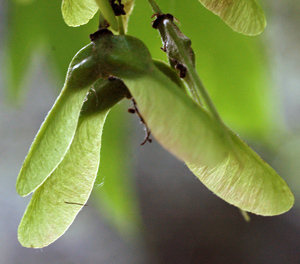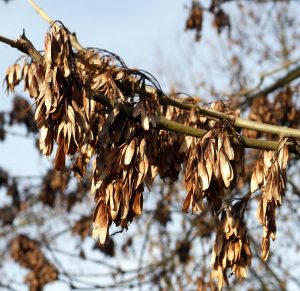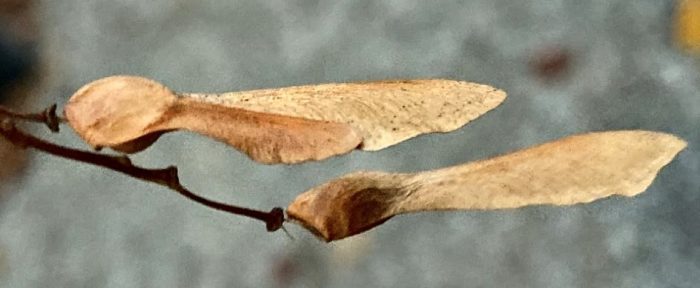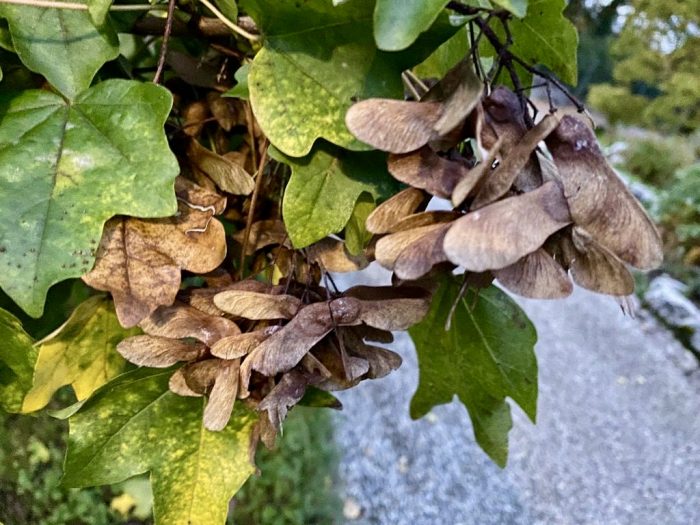Winged seeds

What do the seeds of ash, sycamore and maple trees have in common? They all are enclosed in a wing-like structure that helps them disperse - away from the parent plant and indeed each other. Wind dispersal is also known as anemochory. Effective fruit / seed dispersal provides a tree's offspring with the chance to colonise a new area, and reduces competition for resources with their parent and siblings; it also reduces the likelihood of infection with pests and pathogens.
A single Ash tree (Fraxinus excelsior) can produce thousands of fruits (also known as keys) in large clusters attached to the tips of its branches. Each fruit is known as samara - in which a flattened wing develops from the ovary wall. The flattened wing is made of a fibrous, paper tissue. The seed can be in the centre of the wing (as seen in the elm), or to one side (e.g. in the ash). Where the seed is on one side, with the wing extending on the other side, then the structure will autorotate as it falls, as is the case in the maples and ash trees.  The sycamore produces a double samara, where two one seeded wings are joined together - to form a helicopter-like structure (sometimes known as spinning jennies).
The sycamore produces a double samara, where two one seeded wings are joined together - to form a helicopter-like structure (sometimes known as spinning jennies).
The effectiveness of these winged seeds was investigated by researchers from Caltech and the University of Wageningen. They created plastic models of the seeds and measured their ‘spin’ and descent in tanks of oil. Suspended in the oil were minute glass beads that enabled the scientists to ‘see’ and measure the movement of the oil (air) around the spinning ‘fruits’. They were able to show that the wings of the falling fruits generate more lift than would be expected by regarding the wings as aerofoil sections. In fact, the leading edge of the rotating wings has a high angle of attack, so a stable vortex forms. This vortex joins with the one at the tip creating a cone of low pressure above the wing. It is this region of low pressure that slows the descent of the winged fruit; allowing for the potential of greater dispersal.

Samara - winged, papery and fibrous
The effectiveness of the sycamore double samara is testified by the establishment of the sycamore across much of the U.K. The tree was probably introduced into the UK circa 1500 AD and has readily invaded disturbed habitats such as plantations, abandoned farmland, brownfield land, railway lines, roadsides verges and hedgerows.

Comments are closed for this post.
Discussion
During my childhood, there was a sycamore tree on a corner of cultivated arable land, with no other sycamores in sight. It was a big tree, and it entered the language of the village. The bus service was an example, ‘half to the big tree‘ everybody knew what it meant.
The village was Norton Canes in the West Midland of the UK. How could that lone tree grow there? The village has a long history, could it be 250 years old?
Hello, do maple (Acer) fruits (helicopters) always split apart during germination? I have only seen images of a single-winged seed rising above the soil as the seedling grows but it is evident from looking at the base of many acers that the fruits do not all split apart as they fall from the tree. I have seen some illustrations of a double-winged fruit rising from the soil but no photographs. Many thanks!
Which way up dose sycamore seed fly / descend?
That is wings up on top or round rd seed parts upwards?
I want to draw & wonder which way up they are as they fly?
Assume heavier seeds will be underneath ?
Double-winged fruit of Dipteronia, a genus of plants sister of the Acer / Maple genus. Includes two species found in south-eastern and central China

In reply to Dr John Whitehouse.
according to https://heartofenglandforest.org/sycamore, a sycamore may live for 400 years.
Blogs
13 June, 2023